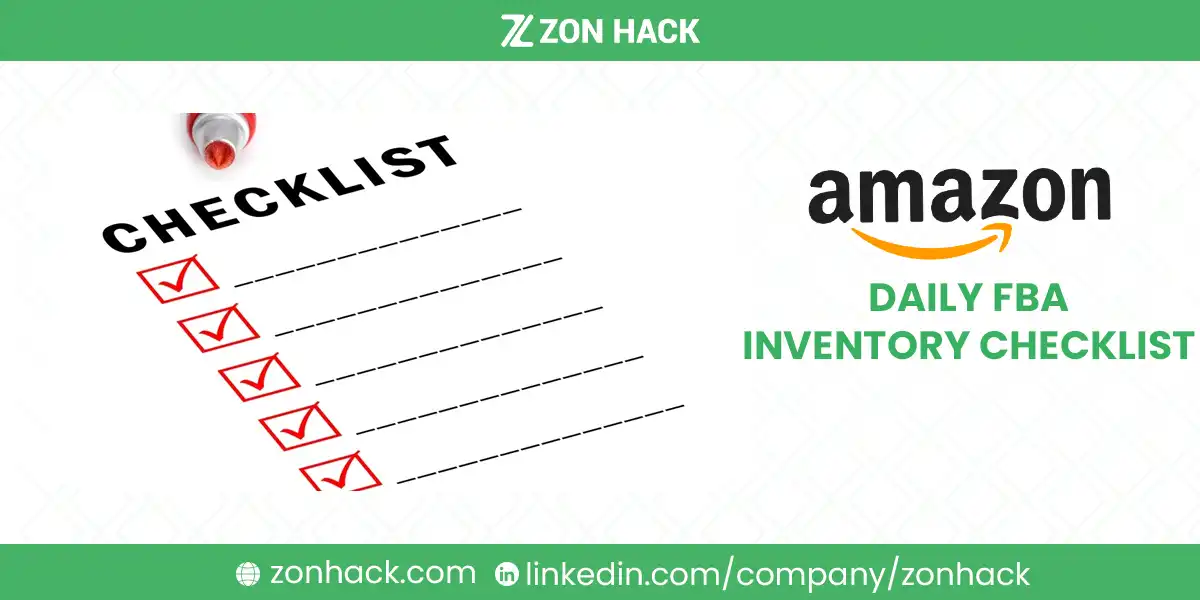If you’re an Amazon FBA seller, keeping track of your inventory and account health daily isn’t just a good habit—it’s a must. Missing key updates or letting inventory issues slip can quickly snowball into lost sales, unnecessary fees, or even account suspensions. With a solid daily checklist, you can stay ahead of the game, ensuring smooth operations and long-term success.
This guide provides a clear, actionable daily checklist for FBA inventory management, covering account health, listing quality, customer interactions, and inventory control. By following these steps, you’ll reduce risks and maximize your performance on Amazon.
Daily Seller Central Essentials Checklist
1. Monitor Sales Performance
Your sales performance is a window into your business’s health. Begin each day by reviewing metrics like daily sales, conversion rates, and Buy Box retention. Use the Business Reports in Seller Central to spot trends and anomalies that may need immediate attention.
For example, if conversion rates drop suddenly, it might signal a listing issue or negative customer reviews. Catching these early can help prevent a ripple effect on your sales.
2. Inventory Health Check
Inventory mismanagement can lead to stockouts or overstocking—both of which are costly. Use the FBA Inventory Reports to:
- Track available, inbound, and reserved inventory.
- Identify stranded inventory and resolve issues promptly.
- Calculate inventory turnover rates to plan restocks effectively.
Amazon’s Inventory Performance Index (IPI) is also vital. A high IPI score minimizes storage fees and increases your storage limits. Aim for an IPI score above 400 for better operational flexibility.
3. Pricing Strategy Updates
Amazon’s dynamic marketplace makes competitive pricing essential. Review your listings to ensure they remain competitive without sacrificing margins. Tools like Amazon Automate Pricing or third-party software can help you adjust prices in response to market trends.
For example, if a competitor runs a promotion, you might adjust your pricing to retain the Buy Box.
4. Review Advertising Campaigns
Evaluate your PPC campaigns to ensure your ad spend aligns with your ROI goals. Focus on metrics like ACoS (Advertising Cost of Sales) and ROAS (Return on Ad Spend) to gauge effectiveness. Adjust bids for underperforming keywords or pause campaigns that aren’t delivering results.
Proactive monitoring ensures your ads drive meaningful traffic without overspending.
Account Health Maintenance Checklist
5. Performance Notifications
Check your Performance Dashboard for alerts or notifications that may require immediate action. Ignoring performance warnings can lead to listing suspensions or account restrictions.
Common triggers include high defect rates, policy violations, or negative customer feedback. Address these issues swiftly to maintain a positive standing.
6. Resolve Customer Feedback & Returns
Responding to customer concerns within 24 hours is critical. Check buyer messages, feedback, and return requests to provide timely resolutions. Prompt responses improve your Order Defect Rate (ODR) and enhance customer satisfaction.
For instance, if a return request cites product defects, investigate the root cause to prevent further issues.
Advanced Inventory Optimization Checklist
7. Long-Term Storage Management
Amazon imposes long-term storage fees for items stored over 365 days. Use the Inventory Age Report to identify slow-moving stock and implement strategies to clear it, such as running promotions or creating bundles.
8. Restock Planning
Accurate restocking ensures you meet customer demand without incurring excess storage fees. Consider tools like Amazon’s Restock Inventory Tool or third-party solutions like Jungle Scout for demand forecasting.
Example Scenario:
If you sell 200 units monthly and have 600 units in stock, plan your next shipment to arrive before you dip below 200. This avoids stockouts and potential sales loss.
Listing Quality Enhancement Checklist
9. Listing Quality Dashboard
Amazon’s Listing Quality Dashboard highlights opportunities to improve product discoverability and reduce returns. Optimize:
- Titles with high-impact keywords.
- Images to meet Amazon’s technical and aesthetic standards.
- Descriptions for clarity and SEO alignment.
10. Retain the Buy Box
Winning the Buy Box is crucial for sales. Ensure:
- Competitive pricing.
- Positive customer feedback.
- Prompt shipping metrics (especially for FBM sellers).
Tools like Amalytix can simplify Buy Box tracking for sellers with multiple SKUs.
Proactive Customer Engagement Checklist
11. Address Case Logs
Check open cases for pending queries or escalations requiring follow-ups. This includes resolving payment issues, shipment delays, or listing problems. Keeping case logs up-to-date demonstrates professionalism to Amazon and customers.
12. Leverage Customer Insights
Monitor reviews and ratings for insights into what customers love or dislike about your products. Use this feedback to improve product quality or refine marketing strategies.
Advanced Amazon FBA Strategies for Success
Incorporating advanced tools and strategies into your daily routine can significantly improve efficiency. For instance, inventory forecasting tools like Jungle Scout help predict demand, ensuring you reorder at the right time. This minimizes risks of stockouts or overstocking.
Repricing strategies are also essential for staying competitive. Automated repricing tools can adjust your prices based on competitor behavior, maximizing your chances of winning the Buy Box.
Maintaining a close relationship with your suppliers is another valuable practice. Regular updates on lead times or production delays allow you to plan inventory levels better. If you’re running promotions or expecting seasonal demand spikes, such communication becomes even more critical.
FAQs
How often should I check my inventory?
Daily. Consistent monitoring helps prevent stockouts, excess storage fees, and performance issues.
What is the IPI score, and why is it important?
The Inventory Performance Index (IPI) reflects how efficiently you manage inventory. A higher score allows for more storage and reduces fees.
How can I avoid long-term storage fees?
Keep an eye on inventory age and use promotions or removals to clear slow-moving stock.
What tools can help with inventory management?
Popular options include Jungle Scout, Helium 10, and InventoryLab for tracking and forecasting inventory needs.
Summing Up
By following a comprehensive daily FBA inventory checklist, you can streamline your operations and improve sales performance. Focus on maintaining account health, optimizing listings, and staying proactive with inventory management. With tools and best practices in place, you’ll be better equipped to navigate the challenges of selling on Amazon.




